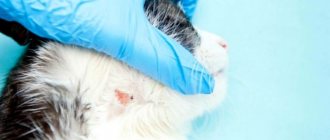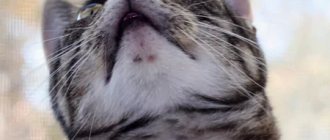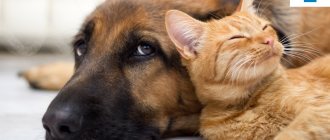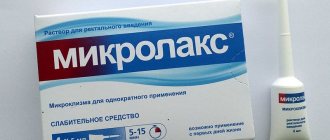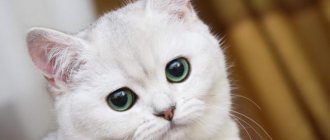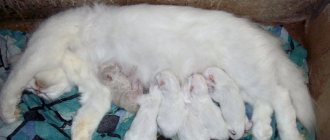Some cat owners, when acne appears on their pet's chin, do not perceive it as a serious danger. Most people hope that acne will disappear on its own after some period of time. But, as practice shows, ignoring this problem often leads to dangerous consequences for the health of the animal. In order not to lead to a worsening of the situation, everyone should know what can contribute to the development, how the pathology manifests itself, and also what measures should be taken to get rid of it.
The main causes of the disease in cats
It is quite difficult to immediately say why inflammation of the animal’s skin occurs. Therefore, it is extremely important to correctly detect the location of acne in your pet. The place where it appears will indicate the cause of the disease. Mostly in animals, blackheads appear in the area of the lips and chin. Veterinarians identify the following causes of the disease:
- Low stress resistance in the animal. After a change of environment, for example, very often there is a disruption in the functioning of the sebaceous glands.
- Insufficient hygiene, poor cleaning of the animal's chin.
- An unusual change in the functioning of the sebaceous glands, as well as in the cat’s hair follicles.
- The animal's immune system is quite weakened. Acne tends to appear at moments when the body loses all its defenses.
- If low quality plastic utensils are used for food.
These are just a few of the main causes of acne in animals, which can lead to dire consequences. The main requirement for the owner is to closely monitor the condition of his animal.
Mycoplasmosis
Another probable reason why a cat has blackness around its mouth is mycoplasmosis. The disease is infectious and develops due to the action of single-celled microorganisms of the same name - mycoplasmas.
The disease is characterized by a number of symptoms:
- Conjunctivitis.
- Purulent discharge from the eyes and nose.
- Loss of appetite.
- Changes in the color of the mucous membranes.
Often, infection is accompanied by the formation of dark spots around the mouth, on the tongue and on the mucous membrane of the lips. Mycoplasmosis is most dangerous for pregnant cats, as it can cause miscarriage.
The disease develops against the background of decreased immunity, since mycoplasmas belong to the group of opportunistic microorganisms that are always present in the animal’s body. Therapy is based on measures to strengthen the immune system and the use of antibacterial agents.
How to correctly identify acne in a cat
Some types of cats have a chronic form of skin disease. When treating pathologies in animals, it is possible to completely eradicate the possibility of a secondary infection, which can aggravate the animal’s condition.
There are numerous symptoms by which you can easily detect some abnormalities in a cat. If you detect them earlier , then it is possible to treat your pet in time without consequences for its health. What you should pay attention to:
- Overflow of blood vessels on the skin.
- Small acne with a white or black surface.
- A gradual increase in size of acne and its growth on the surface of the cat's face.
- Noticeable swelling near the lips.
- Vivid inflammation of ulcers and nodes in the follicles.
- Painful itching.
- Partial baldness of a cat.
The latest symptoms indicate an advanced stage of acne. The pet tries to relieve the itching by scratching the wound for a long time, which leads to discomfort and a bloody crust. Those follicles that become damaged cannot produce hair again, so the cat begins to gradually go bald.
Lentingo, what is it?
These skin defects have the intricate name “Lentigo”. Lentigo is an absolutely harmless skin defect, about a centimeter in size, in the form of a dark spot. Essentially, they are similar to our age spots. Most often, lentigo appears in cats of red or tortoiseshell color. Many veterinarians suggest that pigmentation is associated with the color of the animal's coat. As a rule, they appear in cats in the first years of life.
Lentigo can be seen on the lips, nose and ears. First, minor spots ranging in size from 1-10 mm appear. Gradually the number of spots will increase and increase in size. But over time they will decline. Lentigo does not cause discomfort, pain, itching in the animal, and does not peel off. However, we should not forget that a really dangerous disease can be mistaken for Lentigo. Therefore, you should not make diagnoses yourself. In any case, you need to contact a veterinarian, where a sample of skin tissue will be taken from your pet and sent to the laboratory for tests, where an accurate diagnosis will be established!
If you urgently need to get yourself an MRI and you are in the glorious city of Saratov, then you can find out the price of an MRI in Saratov by clicking on this link. The medical center is always ready to help, be it an MRI or treatment of a disease, but it’s better to be healthy, rich and happy! That’s what the “Red Cat” website wishes for you!
Watch the graceful trained cats perform! Such funny little pussies!
Thank you for your likes and comments, come again! Health to your furry pets!
Ginger cats and cats are amazing creatures - mysteries! They give their tenderness, kindness and joy to people!
Did you like the post on the Red Cat website? Click on the buttons below if you liked the article. Please press everything one by one, thank you!
What are some skin diseases similar to acne in cats?
Before starting treatment , it is necessary to accurately determine the disease in your pet. Only a veterinarian will tell you the correct diagnosis after a thorough examination of the animal in the clinic. What appears on an animal’s face can indicate not only acne, but also other skin diseases. The symptoms of many diseases coincide, it is recommended not to draw hasty conclusions. The most similar causes in terms of symptoms:
- allergy,
- dermatophytosis condition,
- scabies,
- granuloma of the eosinophilic group,
- demodicosis reaction.
In order to completely exclude or confirm a fungal or parasitic group of skin lesions, a scraping study should be carried out. It is recommended not to jump to conclusions and make a diagnosis based only on symptoms. For an accurate diagnosis, laboratory data is required.
Step-by-step treatment
Treating acne in cats at home is quite simple. The main requirements are to maintain hygiene and sterilize the area with sore skin. This is what will help reduce the risk of new onsets of the disease. Any treatment must be coordinated with a veterinarian, since the animal’s condition may worsen if the diagnosis is incorrect. But if you are completely sure that your pet is experiencing discomfort due to blackheads and acne, you should take a number of actions to avoid a growing problem:
- It is recommended that you regularly shampoo your pet on the affected area, thoroughly and gently.
- Before starting the procedure, the area should be neutralized with 3% hydrogen peroxide.
- If the animal has long hair, it is necessary to shave the hair in the affected area.
- The preparations that need to be applied to the area must dissolve the keratinized part of the skin.
- The use of antibiotics to treat acne in cats occurs only in advanced cases, when black spots on the chin begin to grow.
Home treatment should always be carried out carefully and using sterile items. Fluffy pets will try to escape from your hands in every possible way, not succumbing to your intervention.
Blackness and character
It is widely believed that black spots in a cat’s mouth are a sign of an aggressive, evil character. Especially when located on the palate or the inside of the lips. However, it has been proven that pigmentation does not affect the pet’s behavior in any way. With spots, he can be kind, affectionate, and flexible.
In 99% of cases, dark spots are not dangerous. They are normal pigmentation. If this is a concern, consult your veterinarian. Malignant tumors are rare, but are more often found in a severe stage and cannot be treated.
Is it worth it to self-medicate?
Many owners use lotions and scrubs to relieve painful itching in their pet. The use of such medications can lead to poor health. Black spots on the chin should be treated only with proven remedies. Home treatments can cause allergic acne .
Treatment should be carried out by a knowledgeable person - a veterinarian. The first signs of acne in cats appear noticeably; after they are detected, it is recommended to visit a specialist. It is he who will competently conduct laboratory tests, make a diagnosis and prescribe treatment that must be followed. Any changes must be agreed upon.
Only by the size of the rash can one determine the degree of complication of the disease. When a cat's acne is at a minimal stage, local treatment of the animal is prescribed, but if the affected skin has reached large proportions, a comprehensive series of actions is applied . When treated by a specialist or at home, you should:
- do not squeeze out existing blackheads and pimples,
- adjust the proper nutrition of your pet, while eliminating all possible allergic sources that serve as irritants,
- Treatment should be carried out until the cat has completely recovered.
It is important to remember the principles of treatment - do not abuse 'folk' remedies. The pet must undergo a course of laboratory tests in order to know the diagnosis for sure. Based on the diagnosis, it will be easier to cure the cat.
More serious problems
Thus, a cat's tongue can be a real "barometer" of health. A change in color is an indicator that your cat may be sick. You can remember a simple truth: “A pink tongue is a healthy pet.” This rule is immutable; exceptions are very rare.
Why is that? The fact is that the tongue, as a muscular organ, is literally penetrated by many blood vessels, visible through the thin epithelial layer. If it is pink, everything is in order - the blood supply is normal, the red blood cells contain the required amount of hemoglobin. In many cases, a white tongue is a sign of poor oral hygiene, but below we will describe much more serious pathologies in which this organ also changes its color.
Effective remedies for rashes in pets
Before you begin home treatment for acne in cats, you need to decide on a list of necessary medications. The best treatment method would be healing shampoos with tar soap. It is these solutions that can provide maximum antiseptic and antiseborrheic effect. It is worth applying the mask regularly. Calendula tincture soaked in a gauze bandage will reduce the severity of the disease in a few days.
A drug for the treatment of acne in cats based on Furacilin is found in Perkutan. A similar prescription can be purchased at any veterinary pharmacy. The main requirement is that contact with the eyes is unacceptable .
When a secondary focus of infection occurs with the appearance of a bloody crust and abscess, antibiotics are used. For the speedy restoration of the skin, preparations with vitamins A and retinol-containing medications will help.
You should use cosmetics at home for treatment only as prescribed by a specialist. It is necessary to exclude all fatty types of food, replacing them with vitamin supplements.
Folk wisdom in the treatment of acne
Traditional medicine is always popular with supporters of natural treatment. Here are some recipes:
- Two tablets of ground furatsilin with three tablespoons of chamomile decoction. Store the solution in a cool place. Lubricate black spots on the cat’s chin 6-7 times a day.
- You can treat a problem in a cat with fresh pumpkin juice, rubbing the affected area several times a day.
- Mix a few tablespoons with dry herbs and cook in one liter of water. Lotions are made 4-5 times a day.
For various reasons, acne may appear on a cat's chin. Effective remedies will tell you how to treat this disease. The main point is that it is not recommended to apply lotions more than 10 times per day. Do not overdry the skin of your pet's face.
Acne and blackheads can occur at any age in a cat, regardless of breed, gender or weight. The disease is common among domestic animals.
Treatment for this type of disease is not so difficult. The basic rules are not to self-medicate, observe the basic requirements of cat hygiene and its nutrition should be rational.
Preventive measures
Hygiene is very important when preventing acne
To ensure that blackheads no longer bother your pet, you need to adhere to the following recommendations:
- If after eating your cat constantly walks around with the remains of dried food on its face, the contaminated area should be wiped with wet wipes (they should be alcohol-free and fragrance-free);
- Choose only high-quality products and feed;
- Check your cat for fleas at least once a week (you need to examine the fur in the area of the hips, belly and withers);
- Do not give your pet strong medications without a doctor's prescription;
- If a cat often goes outside, you need to regularly wipe its paws and bathe it once a month;
- Once every three months, attention should be paid to the prevention of worms;
- Try to protect your pet from stress;
- Buy vitamins for your cat periodically;
- Do not delay going to the vet if you observe any alarming symptoms.
Have a purring day!
